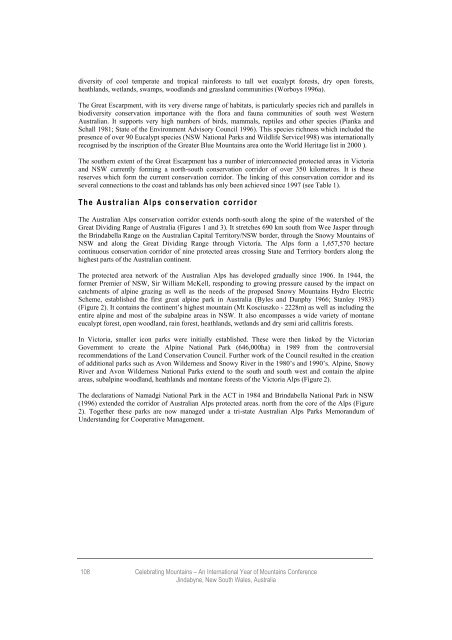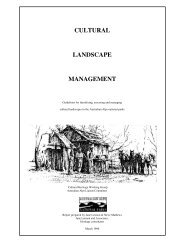Proceedings of an International Year of Mountains - Australian Alps ...
Proceedings of an International Year of Mountains - Australian Alps ...
Proceedings of an International Year of Mountains - Australian Alps ...
You also want an ePaper? Increase the reach of your titles
YUMPU automatically turns print PDFs into web optimized ePapers that Google loves.
diversity <strong>of</strong> cool temperate <strong>an</strong>d tropical rainforests to tall wet eucalypt forests, dry open forests,<br />
heathl<strong>an</strong>ds, wetl<strong>an</strong>ds, swamps, woodl<strong>an</strong>ds <strong>an</strong>d grassl<strong>an</strong>d communities (Worboys 1996a).<br />
The Great Escarpment, with its very diverse r<strong>an</strong>ge <strong>of</strong> habitats, is particularly species rich <strong>an</strong>d parallels in<br />
biodiversity conservation import<strong>an</strong>ce with the flora <strong>an</strong>d fauna communities <strong>of</strong> south west Western<br />
Australi<strong>an</strong>. It supports very high numbers <strong>of</strong> birds, mammals, reptiles <strong>an</strong>d other species (Pi<strong>an</strong>ka <strong>an</strong>d<br />
Schall 1981; State <strong>of</strong> the Environment Advisory Council 1996). This species richness which included the<br />
presence <strong>of</strong> over 90 Eucalypt species (NSW National Parks <strong>an</strong>d Wildlife Service1998) was internationally<br />
recognised by the inscription <strong>of</strong> the Greater Blue <strong>Mountains</strong> area onto the World Heritage list in 2000 ).<br />
The southern extent <strong>of</strong> the Great Escarpment has a number <strong>of</strong> interconnected protected areas in Victoria<br />
<strong>an</strong>d NSW currently forming a north-south conservation corridor <strong>of</strong> over 350 kilometres. It is these<br />
reserves which form the current conservation corridor. The linking <strong>of</strong> this conservation corridor <strong>an</strong>d its<br />
several connections to the coast <strong>an</strong>d tabl<strong>an</strong>ds has only been achieved since 1997 (see Table 1).<br />
The Australi<strong>an</strong> <strong>Alps</strong> conservation corridor<br />
The Australi<strong>an</strong> <strong>Alps</strong> conservation corridor extends north-south along the spine <strong>of</strong> the watershed <strong>of</strong> the<br />
Great Dividing R<strong>an</strong>ge <strong>of</strong> Australia (Figures 1 <strong>an</strong>d 3). It stretches 690 km south from Wee Jasper through<br />
the Brindabella R<strong>an</strong>ge on the Australi<strong>an</strong> Capital Territory/NSW border, through the Snowy <strong>Mountains</strong> <strong>of</strong><br />
NSW <strong>an</strong>d along the Great Dividing R<strong>an</strong>ge through Victoria. The <strong>Alps</strong> form a 1,657,570 hectare<br />
continuous conservation corridor <strong>of</strong> nine protected areas crossing State <strong>an</strong>d Territory borders along the<br />
highest parts <strong>of</strong> the Australi<strong>an</strong> continent.<br />
The protected area network <strong>of</strong> the Australi<strong>an</strong> <strong>Alps</strong> has developed gradually since 1906. In 1944, the<br />
former Premier <strong>of</strong> NSW, Sir William McKell, responding to growing pressure caused by the impact on<br />
catchments <strong>of</strong> alpine grazing as well as the needs <strong>of</strong> the proposed Snowy <strong>Mountains</strong> Hydro Electric<br />
Scheme, established the first great alpine park in Australia (Byles <strong>an</strong>d Dunphy 1966; St<strong>an</strong>ley 1983)<br />
(Figure 2). It contains the continent’s highest mountain (Mt Kosciuszko - 2228m) as well as including the<br />
entire alpine <strong>an</strong>d most <strong>of</strong> the subalpine areas in NSW. It also encompasses a wide variety <strong>of</strong> mont<strong>an</strong>e<br />
eucalypt forest, open woodl<strong>an</strong>d, rain forest, heathl<strong>an</strong>ds, wetl<strong>an</strong>ds <strong>an</strong>d dry semi arid callitris forests.<br />
In Victoria, smaller icon parks were initially established. These were then linked by the Victori<strong>an</strong><br />
Government to create the Alpine National Park (646,000ha) in 1989 from the controversial<br />
recommendations <strong>of</strong> the L<strong>an</strong>d Conservation Council. Further work <strong>of</strong> the Council resulted in the creation<br />
<strong>of</strong> additional parks such as Avon Wilderness <strong>an</strong>d Snowy River in the 1980’s <strong>an</strong>d 1990’s. Alpine, Snowy<br />
River <strong>an</strong>d Avon Wilderness National Parks extend to the south <strong>an</strong>d south west <strong>an</strong>d contain the alpine<br />
areas, subalpine woodl<strong>an</strong>d, heathl<strong>an</strong>ds <strong>an</strong>d mont<strong>an</strong>e forests <strong>of</strong> the Victoria <strong>Alps</strong> (Figure 2).<br />
The declarations <strong>of</strong> Namadgi National Park in the ACT in 1984 <strong>an</strong>d Brindabella National Park in NSW<br />
(1996) extended the corridor <strong>of</strong> Australi<strong>an</strong> <strong>Alps</strong> protected areas. north from the core <strong>of</strong> the <strong>Alps</strong> (Figure<br />
2). Together these parks are now m<strong>an</strong>aged under a tri-state Australi<strong>an</strong> <strong>Alps</strong> Parks Memor<strong>an</strong>dum <strong>of</strong><br />
Underst<strong>an</strong>ding for Cooperative M<strong>an</strong>agement.<br />
108<br />
Celebrating <strong>Mountains</strong> – An <strong>International</strong> <strong>Year</strong> <strong>of</strong> <strong>Mountains</strong> Conference<br />
Jindabyne, New South Wales, Australia

















